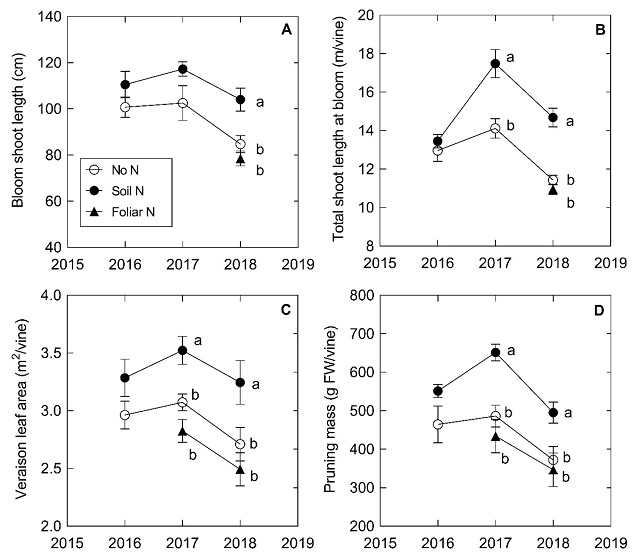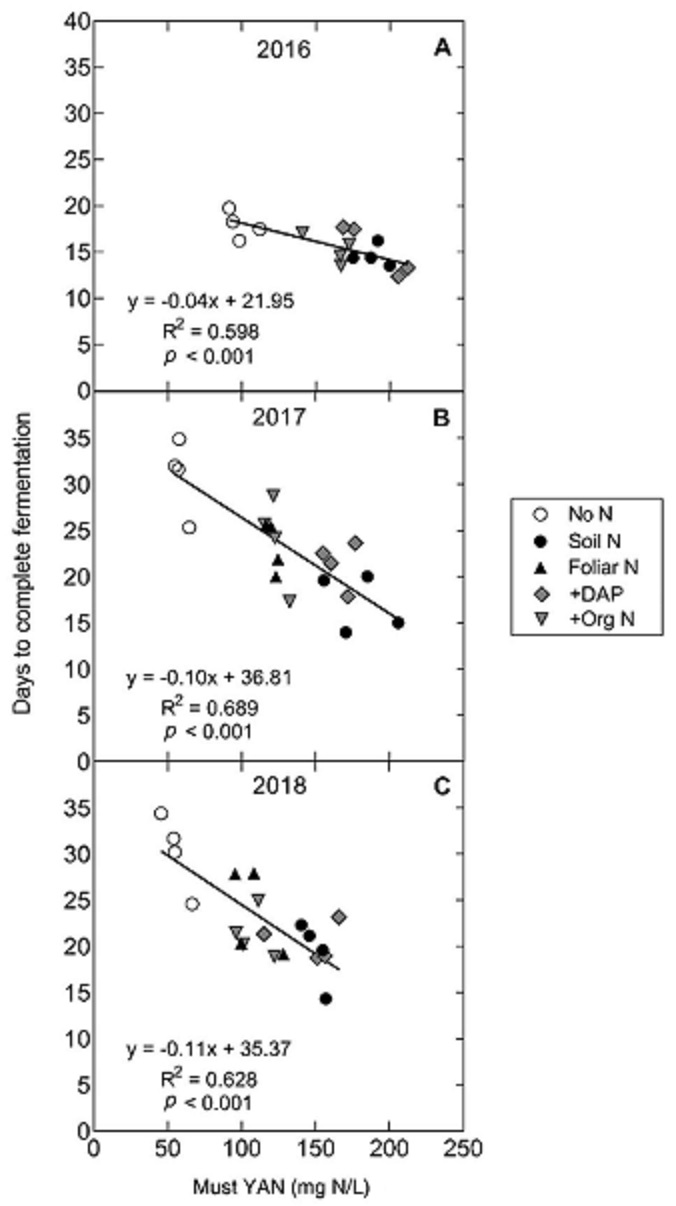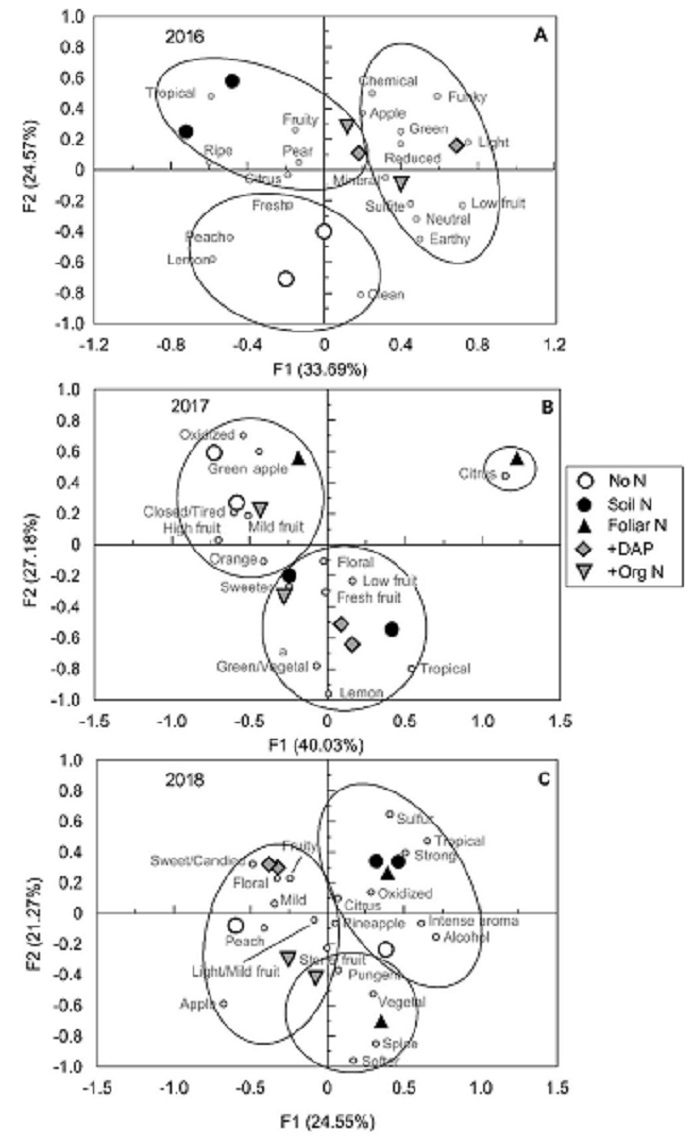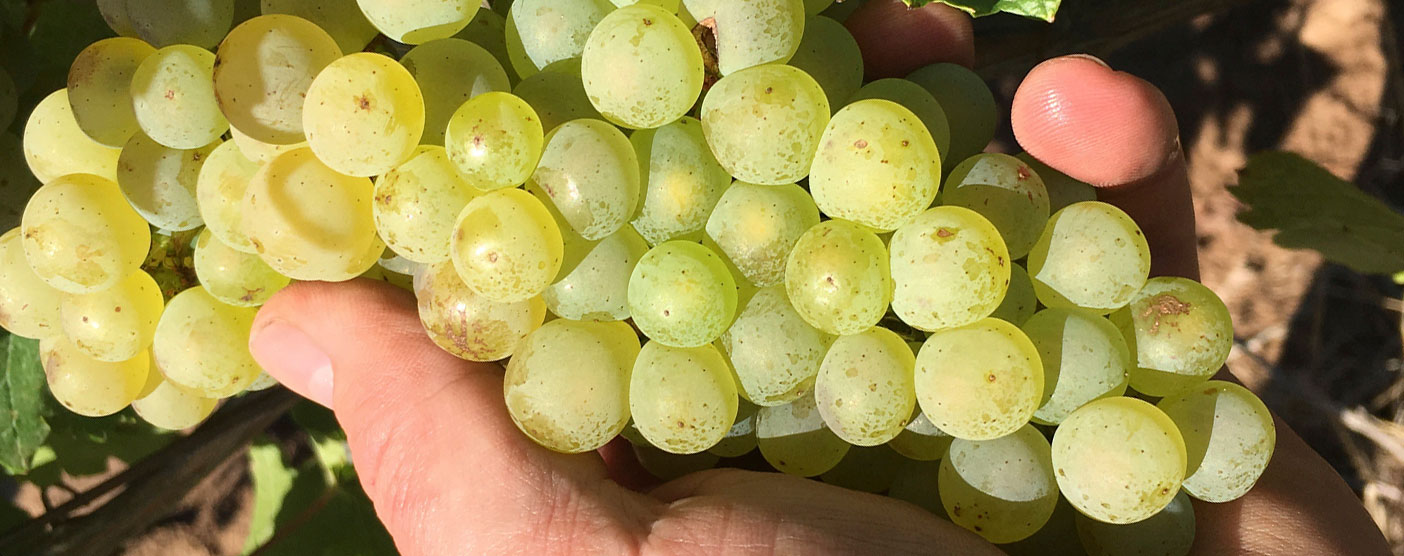Fortunately, for us, it has been answered in a research paper. And not just any old research paper.
The American Society for Enology and Viticulture (ASEV) has selected this paper, which compares the effects of vineyard nitrogen fertilization to winery nitrogen addition in Chardonnay, as the best oenology paper published in the American Journal of Enology and Viticulture.
In brief, the paper compared the impact of nitrogen (N) fertilization in a Chardonnay vineyard in Oregon on vine productivity, fermentation, and wine sensory properties to that of winery N addition.
The US researchers looked at five treatments over three years (2016 to 2018):
- No vineyard or winery N addition (No N)
- Addition of diammonium phosphate in the winery (+DAP)
- Addition of organic N in the winery (+Org N)
- Addition of N to the vineyard soil (Soil N)
- Addition of N to foliage (Foliar N)
Fermentations proceeded more quickly in Soil N musts than in No N musts, with the Foliar N, +DAP, and +Org N treatments intermediate between Soil N and No N treatments. Wine sensory analysis revealed that Soil N wines were most distinct, with greater tropical fruit aromas – a trait that may or may not be desirable in a Chardonnay wine.
The researchers concluded: “These findings show that while winery N additions provide similar fermentation kinetics to vineyard N fertilization in Chardonnay, they may not produce a wine with similar sensory characteristics.”
Here is an edited version of the paper. You can find the full paper here.
Fertilize or Supplement: The Impact of Nitrogen on Vine Productivity and Wine Sensory Properties in Chardonnay
By Tian Tian, Meghan Ruppel, James Osborne, Elizabeth Tomasino, R. Paul SchreinerNitrogen (N) is an essential nutrient required by grapevines and wine yeasts. In the vineyard, N availability influences vine N status, vine growth, and fruit composition, and is often the most important nutrient to manage (Bell and Robson 1999, Conradie 2001a, Linsenmeier et al. 2008, Schreiner et al. 2018). In the winery, must N, especially yeast assimilable nitrogen (YAN), plays a critical role in fermentation kinetics and the production of fermentation-derived aromas (Bell and Henschke 2005, Ugliano et al. 2008, Torrea et al. 2011). Since N has broad impacts in the vineyard and winery, studies have evaluated how vineyard N application or winery N supplementation influences must composition and wine style (Webster et al. 1993, Conradie 2001b, Ugliano et al. 2008, Torrea et al. 2011, Schreiner et al. 2014, 2018, Tahim and Mansfield 2019). However, no published research to date has compared vineyard N fertilization to winery N addition for their effects on must and wine composition in a systematic manner.
An important goal for N management in the vineyard and winery is to ensure that there is sufficient YAN present in the must for a successful fermentation. The minimum YAN required for successful fermentation is between 120 and 140mg N/L (Bell and Henschke 2005), although others propose higher targets for must YAN (200 to 250mg N/L) to reduce the risk of stuck or sluggish fermentation (Bisson and Butzke 2000, Mendes-Ferreira et al. 2004). While grape musts with low levels of YAN (In the vineyard, N can be applied to the soil or to the foliage, and both application methods can influence fruit composition. N applied to the soil consistently results in a significant increase in vine N status and fruit N status across varieties and growing regions (Bell and Robson 1999, Conradie 2001a, 2001b, Linsenmeier et al. 2008, Schreiner et al. 2013, 2018). Since vine N status is a primary driver of vine growth, soil N application often results in larger canopies and higher yields (Bell and Robson 1999, Conradie 2001a, Linsenmeier et al. 2008, Schreiner et al. 2013, 2018). However, when N fertilization boosts vine N status to an excessive level, an overly vigorous canopy leads to excessive fruit shading, less color development in berries, and a greater chance of Botrytis infection (Keller et al. 1999, Hilbert et al. 2003). Foliar N application, on the other hand, can increase fruit YAN without altering canopy growth or yield. N applied to the canopy (most often as urea) between bloom and harvest diffuses into the leaves and is translocated to the fruit, or diffuses into the fruit directly, resulting in higher fruit N with limited impact on vine growth or yield (Lasa et al. 2012, Tozzini et al. 2013, Hannam et al. 2014). Foliar N use also carries less risk of nitrate leaching to groundwater as compared to soil N applications, since lower quantities of N are applied directly to the foliage (Lasa et al. 2012, Hannam et al. 2016).
Compared to vineyard N additions, winery N supplementation alters the concentration and composition of must YAN in a more specific and precise manner. When must YAN is low, diammonium phosphate (DAP) is added routinely to boost the level of ammonium-N (NH4 +-N), and thus YAN, largely as a precaution to prevent slow fermentation and to reduce the production of undesirable sulfur compounds, such as H2S (Jiranek et al. 1995). Although added DAP can increase fermentation rate, elevating ammonium concentration to an excessive level may increase production of H2S and undesired acetic acid and ethyl acetate characters in wines, decreasing wine sensory quality (Ugliano et al. 2010, Torrea et al. 2011, Tahim and Mansfield 2019). Organic N supplements increase must YAN by increasing primary amino acids, rather than ammonium. Since amino acids are precursors of some fermentation-derived bouquets (e.g., branched-chained and acetate esters), adding amino-N may enhance wine aroma perception while promoting a successful fermentation (Miller et al. 2007, Torrea et al. 2011).
Both vineyard and winery N inputs are expected to affect wine aroma, because must N composition contributes to and regulates the formation of many volatile compounds during fermentation (Bell and Henschke 2005). While prior work has investigated how the concentrations of specific aroma compounds in wine, and the resulting aroma of those wines, respond to either vineyard or winery N inputs (Garde-Cerdán and Ancín-Azpilicueta 2008, Ugliano et al. 2009, Siebert et al. 2018, Yuan et al. 2018b), a direct comparison of how vineyard N inputs compare to winery N inputs to alter the aroma perception of wines has not been reported. Moreover, how the concentration and composition of must YAN affect the mouthfeel of white wines remains unclear. N application in the vineyard alters phenolic composition in berries and wines in red varieties (Hilbert et al. 2003, Schreiner et al. 2014, Yuan et al. 2018b), but in white wines, it is unlikely that the change in phenolics would be large enough to alter mouthfeel perception. As with the wine aroma studies, research investigating changes to phenolic composition have not included a sensory component.
We investigated how boosting must N in the vineyard via fertilization, or in the winery through N supplementation of low N must, altered the sensory properties of Chardonnay wines, compared to maintaining low N status in both vineyard and winery. The specific goals of this study were to understand how fertilization of either soil or foliage with N influences vine N status, canopy growth, yield, and fruit composition, and to compare the effects of vineyard N fertilization to winery N supplementation on must composition, fermentation kinetics, and wine sensory properties. The knowledge gained through this study provides viticulturists and winemakers with greater insight on how to manage N in the vineyard and winery to achieve a desired wine style.
Materials used
N fertilizer was applied to the soil as urea-ammonium nitrate (Soil N) or to the foliage as urea (Foliar N) in the vineyard. Winery N additions included either an inorganic source of N (+DAP) or an organic N supplement (+Org N). Since fruit for the +DAP and +Org N treatments was obtained from the No N plots, only three treatments (No N, Soil N, and Foliar N) were evaluated in the vineyard. Fruit from the Soil N and Foliar N vines received no N additions in the winery.Each treatment was replicated four times, with the finished wines from the replicates blended for sensory analysis.
Results
Soil N application improved vine N status in all years, while N applied to foliage had only a minor influence on vine N status. Across three years, bloom leaf blade and petiole N was 10 to 30% higher in Soil N vines than in No N vines, even in the first year, when the Soil N vines had received only one N application (~3.9 g/vine) prior to sampling. The difference in leaf blade and petiole N between the Soil N and the No N vines became greater at veraison than at bloom. The concentration of veraison leaf blade and petiole N was 20 to 35% higher in the Soil N vines than in the control. Foliar N generally did not affect leaf blade and petiole N at bloom and veraison, except that veraison leaf blade N increased slightly in the Foliar N vines in 2018.Leaf greenness increased with soil N application by midsummer, but was not affected by foliar N application in any year. The SPAD values of opposite-cluster leaves did not differ between the No N and Soil N vines from mid-May to the end of July, except in one case in 2018. SPAD values were higher in the Soil N vines beginning in August of each year, and differences in SPAD of opposite-cluster leaves grew larger between the Soil N and No N vines as each growing season progressed. There was a similar pattern in the upper canopy leaves. On the other hand, Foliar N had no impact on leaf greenness. The SPAD values of opposite-cluster leaves and upper canopy leaves never differed between Foliar N vines and No N vines.
Soil N application stimulated canopy growth beginning in the second year, but foliar N application did not alter vegetative growth parameters (Figure 1). The responses of total shoot length at bloom, leaf area at veraison, and pruning mass at dormancy to soil N addition followed the same pattern. Those parameters of vegetative growth were 15 to 33% greater in Soil N vines than in No N vines in 2017 and 2018.

Figure 1: Effect of vineyard nitrogen (N) applications (Soil N and Foliar N) on vegetative growth of Chardonnay grapevines from 2016 to 2018. Vines that received no N supply (No N) served as the control. Data points represent means and standard error for each treatment in each year (n = 4). Data were analysed separately for each experimental year. Letters near each symbol designate significant groups based on t-test or Tukey’s honest significant difference test at 95% confidence. FW, fresh weight.
Soil N application had only a minor influence on single-leaf photosynthesis rates, increasing it on one of five days when gas exchange was measured. LWP did not differ between the No N and Soil N vines on any single measurement day. However, when data were combined for each season, the seasonal mean value of LWP was slightly lower in the Soil N vines than the No N vines in 2016 and 2018. LWP was measured in the Foliar N vines on three days in 2018 and did not differ from the No N vines on those days. Soil N vines had less fruit exposure to sunlight than the No N vines at some times, most consistently in 2017, but the Foliar N vines did not differ from the No N controls.
Soil N application increased fruit yield beginning in the second year, but fruit yield was unaffected by foliar N application (Figure 2). Fruit yield did not differ between the No N and the Soil N vines in 2016. However, yield increased 30% in the Soil N vines in 2017, due to greater cluster weights and more berries per cluster. In 2018, although no yield components were affected by treatment, yield was 36% higher in the Soil N vines than in the No N vines. Fruitfulness, number of clusters per vine, and average berry weight did not vary among treatments in any year.
.jpg)
Figure 2: Effect of vineyard nitrogen (N) applications (Soil N and Foliar N) on reproductive parameters of Chardonnay grapevines from 2016 to 2018. Vines that received no N supply (No N) served as the control. Data points represent means and standard error for each treatment in each year (n = 4). Data were analysed separately for each experimental year. Letters near each symbol designate significant groups based on t-test or Tukey’s honest significant difference test at 95% confidence.
Soil ammonium and nitrate levels were more responsive to soil N application in 2017 than in 2018, most likely because the Soil N vines received an additional dose of N (22.4 kg N/ha) in 2017. The concentration of NH4+-N and nitrate-N (NO3--N) in soil was relatively consistent in the No N vines over time, but both sources of N were elevated after harvest in the Soil N treatment in 2017. Nitrate was also much greater in the Soil N vines in August 2017. Foliar N applications did not affect soil inorganic N levels.
Vineyard N and winery N additions on must maturity components (TSS, TA, and pH) were minor and not consistent across years. The Soil N musts had a higher concentration of TSS than the No N and +DAP musts in 2016 and a higher pH than the No N, Foliar N, and +Org N musts in 2017. Must TA was not affected by vineyard or winery N treatments. Soil N fertilization altered the concentrations of several mineral nutrients besides N in the must over three years, but foliar N sprays did not affect must nutrients in 2017 and 2018. The concentrations of Ca and Mg were greater in Soil N musts than in No N musts in 2016, but the opposite pattern occurred in 2018. The level of S in musts increased with soil N addition in 2016 and 2017, but not in 2018. Must P concentrations, however, were reduced in response to soil N application in the latter two years of this study.
Both vineyard and winery N additions effectively increased must YAN levels prior to fermentation, but the impacts on NH4 +-N and FAN-N differed among treatments. Must YAN was low in the No N treatment in all years. Soil N application in the vineyard elevated must YAN by 90 to 200% across three years, owing to increases in both NH4 +-N and FAN-N. Foliar N application in the vineyard improved must YAN by 105% in 2017 and by 61% in 2018. The concentration of FAN-N in must was greater in the Foliar N treatment than in the control in 2017, but not in 2018, though must NH4 +-N was unaffected by foliar N application in either year. The addition of DAP at the winery boosted must YAN to a similar level as in the Soil N musts in all three years, by increasing only NH4 +-N in the must. As a result, NH4 +-N accounted for more than 50% of the must YAN in the +DAP treatment, but only 7 to 30% of must YAN in other treatments. Organic N addition in the winery increased must YAN to match the Soil N treatment in 2016, but the concentration of must YAN in the +Org N treatment was similar to the Foliar N treatment in 2017 and 2018. Supplementing organic N in the winery had no influence on must NH4 +-N, but increased must FAN-N by 83 to 160% compared to the control. The concentration of must FAN-N in the +Org N treatment was similar to the Soil N treatment in 2016 and 2018, but matched the Foliar N treatment in 2017.
The level of must YAN influenced the length of time required for yeast to complete alcoholic fermentation. Generally, fermentation proceeded more slowly in the No N treatment musts with 60 to 120mg YAN/L than in the other, higher-YAN musts. While treatment was not significant in 2016, it took about three days longer for the No N musts to finish fermentation than for the Soil N, +DAP, and +Org N treatments. In 2017, fermentation finished 14 days sooner in the Soil N treatment than in the No N treatment, while the Foliar N, +DAP, and +Org N treatments were intermediate between these extremes. A similar pattern was observed in 2018 as in 2017. The number of days to complete fermentation correlated well with the level of must YAN in each year (R2 > 0.59 each season), showing that must YAN was the primary driver of fermentation speed (Figure 3).

Figure 3: Relationship between must yeast assimilable nitrogen (YAN) concentration prior to fermentation and number of days to complete fermentation in Chardonnay musts that received vineyard N applications (Soil N or Foliar N) or winery N additions (+DAP or +Org N) between 2016 and 2018. Musts that received no N input in the vineyard or winery (No N) served as the control. Data points represent raw data and the linear coefficient of determination (R2) was based on all treatments in each year (n = 16 or 20).
Vineyard N fertilization and winery N supplementation had varying influences on the aroma of Chardonnay wines (Figure 4). MFA incorporating the spatial Napping data showed that the first two factors (F1 and F2) accounted for 49.2% of the total variance in 2016, 42.7% in 2017, and 36.8% in 2018 wines. In each year, the wines clustered into three groups. Across all three years, the +Org N sensory replicates always clustered in the same group. In the other treatments, the sensory replicates showed some similarity, but were not always in the same cluster group.

Figure 4: Correspondence analysis of ultra-flash profiling (UFP) data for aroma of Chardonnay wines that received vineyard N applications (Soil N or Foliar N), winery N supplementations (+DAP or +Org N), or no N inputs (No N) between 2016 and 2018. Ellipses indicate groupings calculated using k-means clustering. Two samples of each wine were evaluated in each session.
Correspondence analysis that used the UFP data for aroma indicated that the first two factors explained 58.3% of the variance in 2016, 67.2% in 2017, and 45.8% in 2018 wines (Figure 4). Clustering showed three distinct groups in each year, although across years, the wines and terms associated with each group differed. However, some consistencies were found. The No N wines were characterized by peach and stone fruit aromas in 2016 and 2018, while they were described by apple aroma and some negative descriptors, such as oxidized, closed, and tired, in 2017. The Soil N wines consistently grouped with tropical and fruity notes across all years of the study. Beside the clear association with tropical aromas, the Soil N wines also stood out as most different from all other treatments based on the spatial Napping in 2016. The aroma of the Foliar N wines was not consistent across wine replicates in a given year, nor across the two years that it was applied (Figure 4). However, one replicate in 2017 and 2018 was associated with citrus aromas, while the other replicate of the Foliar N treatment was linked with green apple (2017) or vegetal (2018) aromas. Similarly, both winery N treatments did not produce wines with consistent aromas across years based on UFP analysis. In 2016, the +DAP and +Org N replicates split into two groups, one characterized by more negatively associated descriptors and the other by fruity, pear, and citrus aromas. In 2017, the +DAP wines were associated with tropical and fruity aromas, while the +Org N wines were split between two groups, but closest to orange or mild fruit aromas. In 2018, the +DAP wines were described as sweet/candied, fruity, or floral, and the +Org N wines were closest to peach/stone fruit aromas.
Summary
The purpose of this study was to understand whether wine composition of Chardonnay could be improved by applying N in the vineyard, by supplementing N in the winery, or by maintaining low N status in both vines and musts. Thus, we examined how vineyard N applications and winery N additions affected must YAN levels, fermentation kinetics, and wine sensory properties in comparison to maintaining low N in both vineyard and winery.Soil N application increased vine N status, improved vine productivity, and elevated fruit YAN concentrations, while foliar N did not affect vine N status or vine growth. Foliar N sprays also increased fruit YAN level, although to a smaller extent than soil N application in this Oregon vineyard. So foliar N could be a good tool to increase YAN at vigorous sites, since it does not stimulate vine growth.
Winery N supplementation with DAP boosted must YAN to the same level as soil N fertilization in the vineyard, but only the soil N treatment consistently accelerated fermentation. As we expected, the N source affected the sensory properties of Chardonnay wines. Among all treatments, soil N application in the vineyard altered wine sensory characteristics to the greatest extent, with a consistent increase in tropical fruit aromas.
This trait may or may not be desirable in a Chardonnay wine, depending on the desired wine style. However, using soil N to boost productivity and make a more tropical wine style may be economically beneficial for growers (yield) and winemakers (volume), since fruity wines are more attractive to younger wine consumers.
The team behind the paper (Tian Tian of the University of California Cooperative Extension, Kern County, and Oregon State University, Corvallis's Meghan Ruppel, James Osborne, Elizabeth Tomasino and R Paul Schreiner) will present their paper at the 2023 ASEV National Conference in Napa, California, on June 26-29, 2023.













.png)






